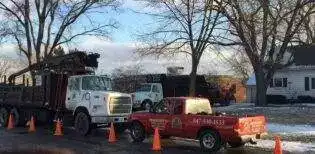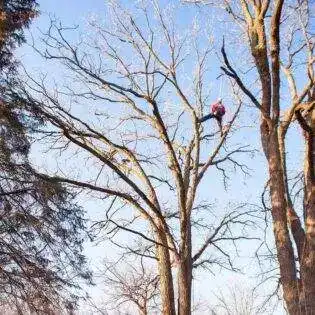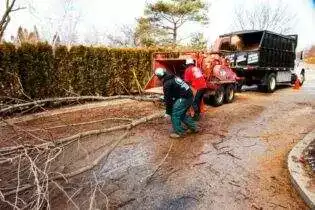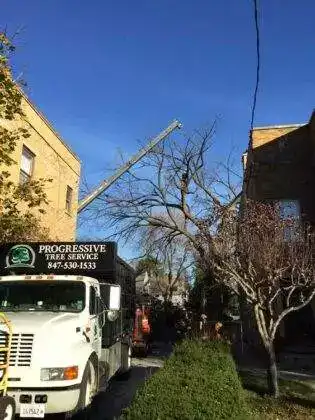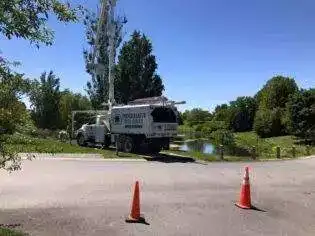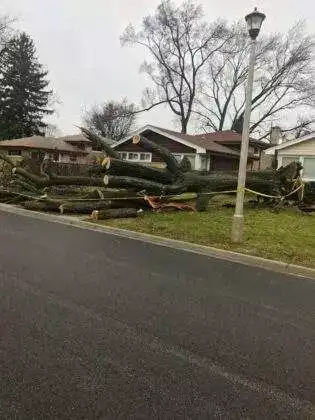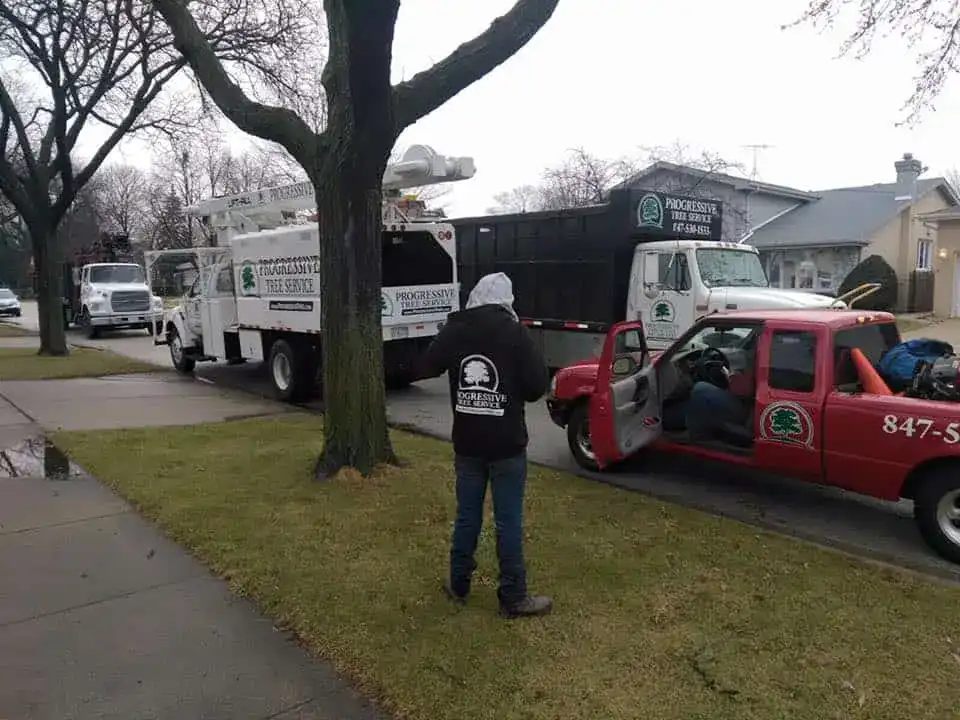At Progressive Tree Service, we understand the significant threat that powdery mildew poses to the health and beauty of Chicago's urban forest. As a leading tree care company in the area, we are dedicated to providing expert solutions for preventing and treating this fungal disease in a wide range of tree species.
Our team of certified arborists and plant health care specialists has years of experience and a deep understanding of Chicago's unique urban environment. We develop customized treatment plans tailored to the specific needs of individual trees and properties, considering factors such as tree species, age, health status, and environmental conditions.
Understanding Powdery Mildew: Symptoms and Impact
Powdery mildew is a fungal disease characterized by a white or gray powdery growth on leaves and stems. Infected leaves may appear distorted, discolored, or prematurely drop from the tree. Our experts know that powdery mildew infections can significantly compromise the health and aesthetic value of affected trees by disrupting photosynthesis, weakening the tree, and making it more susceptible to other stressors such as pests, diseases, and environmental challenges.
Untreated powdery mildew can shorten a tree's lifespan by up to 10 years, emphasizing the importance of early intervention by a professional like those at Progressive Tree Service. We are committed to helping our clients protect their trees and maintain the vitality of Chicago's urban forest.
Susceptible Tree Species in the Chicago Area
Our arborists have identified many tree species in the Chicago area that can be affected by powdery mildew, including oaks (particularly white oak and red oak), maples (including sugar maples and red maples), crabapples, dogwoods, lilacs, London planetrees, and sycamores. However, we understand that every property is unique, and we offer personalized assessments to identify the specific risks and needs of your trees.
Factors Contributing to Powdery Mildew Growth
At Progressive Tree Service, we know that certain environmental conditions can promote the development and spread of powdery mildew in urban trees. While Chicago's warm, humid summers can contribute to powdery mildew growth, our experts also recognize that poor air circulation and shady areas can exacerbate problems even in less ideal climates. The closely spaced trees and altered microclimates of Chicago's urban landscape can further contribute to the spread of powdery mildew, making professional management essential.
Our Approach to Powdery Mildew Prevention and Management
Our company's approach to powdery mildew prevention and management relies on a combination of proper arboricultural practices, targeted treatments, and client education.
Proper Tree Care Techniques
Our arborists employ proven tree care techniques to mitigate the risk of fungal diseases like powdery mildew, including:
- Regular pruning to remove infected or damaged branches and improve air flow
- Mulching to maintain soil moisture and reduce water stress
- Watering deeply and infrequently at the base of the tree to encourage deep root growth and minimize leaf wetness duration
- Monitoring trees regularly for signs of stress or disease and taking prompt action when needed
Targeted Treatments
When powdery mildew infections occur, our plant health care specialists develop targeted treatment plans that may include:
- Applying fungicides specifically effective against powdery mildew at the appropriate times to reduce fungal growth and prevent spread
- Implementing cultural practices, such as selective pruning for air circulation, to create conditions less favorable for powdery mildew development
- Employing resistance management strategies, such as alternating fungicide classes and incorporating non-chemical methods, to prevent the development of fungicide-resistant powdery mildew strains
Here's the div HTML for the two tables with the class "responsive-table":
| Treatment Method | Description | Benefits |
|---|---|---|
| Fungicide Applications | Applying specific fungicides to infected trees at the appropriate times | Reduces fungal growth and prevents spread to nearby trees |
| Cultural Practices | Pruning, mulching, and watering techniques that promote tree health | Creates conditions less favorable for powdery mildew development |
| Resistance Management | Alternating fungicide classes and incorporating non-chemical methods | Prevents the development of fungicide-resistant powdery mildew strains |
Client Education
At Progressive Tree Service, we believe that client education is a crucial component of effective powdery mildew management. Our team takes the time to explain proper tree care practices, disease prevention strategies, and the importance of early intervention to our clients. We are committed to empowering property owners with the knowledge they need to maintain the health and beauty of their trees.
Specific Treatment Considerations for Oak and Maple Trees
As two of the most susceptible tree species to powdery mildew in the Chicago area, oaks and maples require specific treatment considerations to manage the disease effectively.
Tailored Management Strategies for Powdery Mildew on Oak Trees
Our arborists understand that oak trees, particularly white oaks and red oaks, are highly vulnerable to powdery mildew infections. We employ tailored management strategies for oaks, including:
- Selective pruning to improve air circulation and reduce leaf wetness
- Fungicide applications timed to protect new growth and prevent infection
- Maintaining proper soil moisture through irrigation and mulching
Addressing Powdery Mildew in Maple Trees
Maple trees, known for their vibrant fall foliage, can suffer significant aesthetic damage from powdery mildew. Our experts address powdery mildew in maples by:
- Recommending resistant maple cultivars when planting new trees
- Applying fungicides at bud break and during periods of active growth
- Removing and disposing of infected leaves to reduce inoculum levels
| Species | Specific Management Strategies |
|---|---|
| Oaks |
|
| Maples |
|
Benefits of Choosing Progressive Tree Service for Powdery Mildew Management
At Progressive Tree Service, we are dedicated to providing expert solutions for powdery mildew management in Chicago's urban forest. By choosing our company, you can expect:
- Access to a team of certified arborists and plant health care specialists who can provide expert advice on tree selection, planting, and care
- Customized treatment plans tailored to the specific needs of your trees and property
- Use of the latest tools, techniques, and products for effective powdery mildew control
- Commitment to sustainable, environmentally responsible tree care practices
- Comprehensive services, from diagnosis and treatment to ongoing maintenance and prevention
Conclusion: Partner with Progressive Tree Service to Protect Your Trees
At Progressive Tree Service, we understand the significant threat that powdery mildew poses to the health and beauty of Chicago's urban forest. Our team of certified arborists and plant health care specialists is committed to providing expert solutions for preventing and treating this fungal disease in a wide range of tree species.
To protect your trees and contribute to a healthier urban forest, we recommend:
- Monitoring your trees regularly for signs of powdery mildew and other potential issues.
- Implementing proper tree care practices, such as pruning, mulching, and watering, to promote tree health and reduce the risk of infection.
- Consulting with our certified arborists and tree care professionals for expert advice and customized treatment plans.
Partner with Progressive Tree Service today to successfully combat powdery mildew and ensure the long-term health and beauty of your trees. Our experts are ready to provide the personalized care and attention your trees deserve.
Image by Mike Schomaker, Colorado State Forest Service, Bugwood.org
